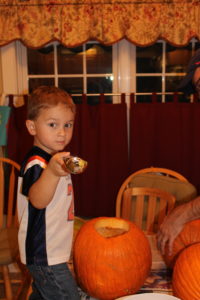
Our little guy gets his hands dirty helping with the pumpkin carving in 2015!
Growing up, carving pumpkins was a big event, but a tedious one. My sisters and I were never allowed to do the actual carving—that was Dad’s job. Wielding a large sharp knife, he would carve each pumpkin under our direction.
The three of us were in charge of scooping out the insides of our pumpkins. We would hunch over our pumpkins, shoulders tense with determination, scooping and scraping away the stringy pumpkin innards for what was an eternity in kid-time. Just when we thought we were done, Dad would say “just a little more”. I still don’t know whether he really needed our pumpkins scraped more, or he was just trying to keep us busy!
Once I was old enough to be trusted with sharp objects, I started carving my own pumpkins. Largely by trial and error, I discovered a few ways to make carving easier, and ways I could create more complex designs.
- Use a small serrated knife, such as a steak knife, to allow for finer detail in designs. Remember though, even small serrated kitchen knives are sharp. The serrated knives in pumpkin carving kits are generally a little safer, since most are not very sharp at all. There are exceptions though.
- Rethink how you cut the top of your pumpkin. There is nothing that says it has to be a round opening. Cutting an opening with at least one flat side will help you know how to line it up when replacing the top. Also, if you make the cut sides slant inward toward the center of the pumpkin, this helps prevent the top from falling through the opening.
- Another option is to not cut the top at all, but to make your opening on the bottom. No need to worry about replacing the cut piece, just set your pumpkin over your light source and you’re all set.

Little man carving his pumpkin in 2016. What a difference a year makes!
- I broke more than one of my Mom’s spoons while scooping out pumpkins as a young girl. Since then I’ve learned to use an ice cream scoop. It’s a lot easier on the hands, and since they are designed to cut through rock-hard ice cream, they are a lot less likely to break.
- I grew up always drawing the design on the pumpkin, usually using a pen or marker and hoping that I didn’t make a mistake that wouldn’t be cut away later. A less anxiety provoking method: use dry erase markers to draw the design on your pumpkin. Any mistakes just wipe off.
- Using a paper pattern is a more advanced level of pumpkin carving, but not impossible. Downloadable patterns on the internet or those that come with pumpkin carving kits use this method. Tape the design drawn on paper to the pumpkin, and puncture through the lines of the design and just enough of the pumpkin to leave a small hole in the outer rind using a sharp pin, tack, or nail.
- After outlining the design with the pin, remove the paper and carve out sections by connecting the dots left in the pumpkin skin. I had doubts about my ability to accomplish this the first time I tried it, but it worked so well it is my preferred method now.
How Long Will a Carved Pumpkin Last?
This depends on three factors: temperature, mold, and moisture. Most of the time carved pumpkins will last a few days before deteriorating. There are ways to add a few additional days to their lifespan.
- The colder the outside temperature, the longer your pumpkin will last. Some very dedicated pumpkin carvers will refrigerate their carved pumpkins when not on display to extend their life by a few days.
Pumpkins and their winter squash cousins store well after harvest because their thick skin prevents rot from setting in and moisture from escaping. Once that skin is cut by carving, fungi and bacteria which rot the pumpkin can move in, and moisture is lost readily, causing the pumpkin to shrivel.
- Reportedly one way to delay rotting is to wash the cut surfaces of your carved pumpkin with a 10% bleach solution to kill microorganisms at least temporarily. After that, you need to seal the surface to prevent moisture loss. There are also commercial preservatives available to do this, but they tend to be relatively costly.
- Another method I’ve tried is to coat cut surfaces with petroleum jelly, but it’s pretty messy. Another method is to spray the cut surfaces with WD-40, or some other type of spray lubricant. Non-stick cooking spray may work too. I have also seen recommendations for using clear spray acrylic or even white glue to seal cut surfaces. Allow the pumpkin to sit for 24 hours before using candles near it, to be sure that any flammable vapors have dissipated.
I recently saw a comparison of commercial pumpkin preservative vs. bleach, acrylic spray, petroleum jelly or white glue for increasing longevity of Jack O’Lanterns.
- Pumpkins were compared on how much they had shriveled and how much bacteria and mold had grown on them.
- Surprisingly, it was a tie between the control (no treatment) and the commercial pumpkin preservative—both produced pumpkins that lasted 14 days before collapsing.
- Soaking in a bleach solution was a close second, at 10 days. The person testing the methods hypothesized that the control pumpkin did so well because the cut surfaces dried enough to inhibit bacteria and mold growth.
Be safe when lighting your pumpkin:
- Consider non-candle options such as battery operated lights of glow sticks. Bonus: these won’t blow out if it’s a windy night!
- Candles in a clear glass jar or holder will be safer and provide more light than an exposed candle.
- Never leave candles unattended.
Make sure you take a few pictures of your pumpkin masterpieces before their relatively short lives end. And remember– a Jack O’ Lantern is a great addition to your compost pile after the holiday is past!
If you liked this post, please subscribe to Grounded and Growing today and receive your copy of “15 Tips to Become a '15 Minute Gardener'” so you can spend less time working ON your garden and more time enjoying being IN your garden.! It’s absolutely free. When you join the Grounded and Growing community, you’ll finally take the garden off your “To-Do” list and allow yourself time to enjoy your garden and savor the peace and serenity there. I tell subscribers about new posts as soon as I hit ‘publish’ and send weekly-ish updates on what’s going on in my garden– good, bad AND ugly.
I find that the worst enemies of pumpkins are squirrels. Any ideas?
Yes, squirrels definitely love pumpkins! If you can put the pumpkins where the squirrels can’t get to them, that is my Mr. Obvious answer. My other thought is to try something with hot pepper in it. Hot pepper flakes in birdseed usually does a good job of deterring squirrels from bird feeders. My thinking is the products with capsaicin (the “active ingredient” in hot peppers) intended for keeping critters away from plants may be a good way to keep them from pumpkins too. You might even be able to use hot sauce wiped over the pumpkin– just guessing on that though. In any case I would make sure to handle the pumpkins with gloves after applying anything with capsaicin– just to protect yourself from the burning effects!
Luv your great ideas Jenny!!
Great blog!!
Can’t wait to use your suggestions when I carve my Pumpkin this year!